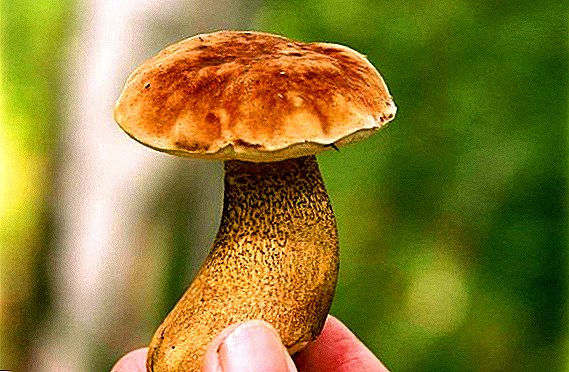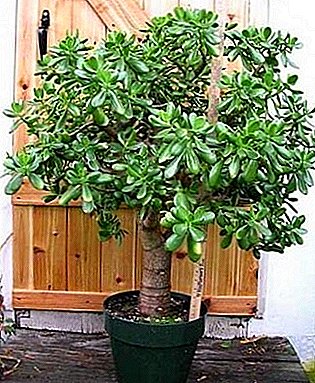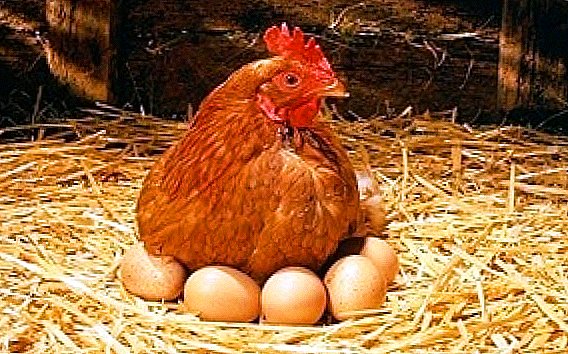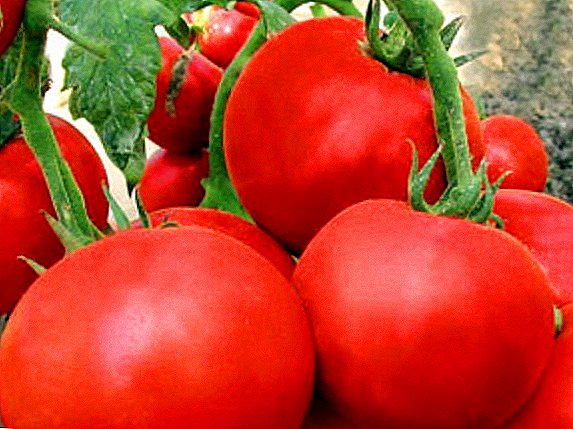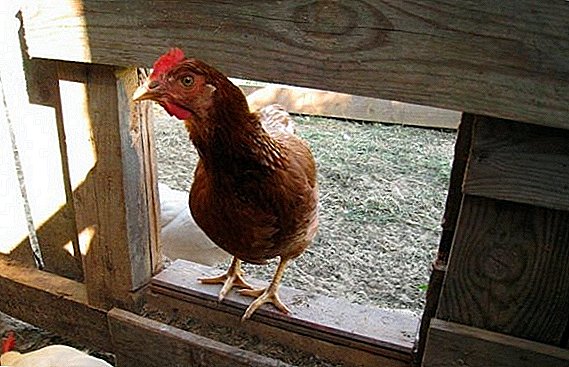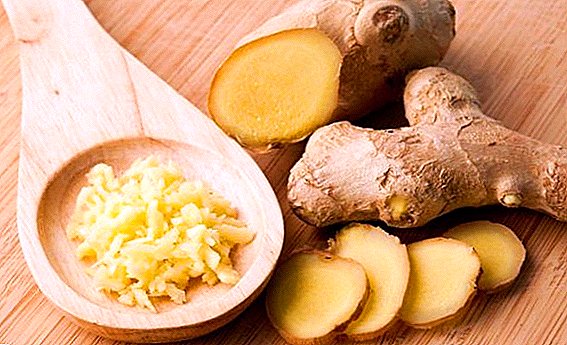
Small plum-shaped tomatoes look very beautiful on the bush, suitable for salads and canning.
One of the brightest representatives - a variety of large cream & raquo. Gardeners planting it on their plot, note the high yield, early maturity and excellent taste of the fruit.
A full description of the variety, its main characteristics and features of cultivation can be found in the article.
Large Cream Tomato: variety description
| Grade name | Large cream |
| general description | Early ripe determinant variety for greenhouses and open ground |
| Originator | Russia |
| Ripening | 100-110 days |
| The form | Plum-shaped fruits with a pointed tip |
| Colour | Red |
| Average tomato mass | 70-90 grams |
| Application | Universal |
| Yield varieties | 7-10 kg per square meter |
| Features of growing | Agrotechnika standard |
| Disease resistance | Resistant to most diseases |
 The grade is removed in Russia, intended for cultivation in greenhouses and an open ground. Can be grown in pots on balconies and verandas. Very yielded, fruits are stored well. Harvested tomatoes in the phase of technical ripeness successfully ripen at home.
The grade is removed in Russia, intended for cultivation in greenhouses and an open ground. Can be grown in pots on balconies and verandas. Very yielded, fruits are stored well. Harvested tomatoes in the phase of technical ripeness successfully ripen at home.
Large Cream is a variety that is ideal for open and closed ground.
Bush determinant, compact, standard. The height of an adult plant is 35-60 cm. The variety is early ripening, depending on the climatic zone, fruits can be harvested in late June or early July.
- Fruits are oval, plum-shaped, with a pointed tip.
- The color is orange red.
- Weight of an average tomato - 70-90 g.
- Taste is pleasant, moderately sweet, not watery.
- Internal cameras are small.
- The flesh is juicy, elastic.
- Dense skin guarantees the safety of tomatoes in canning.
- Fruits are well stored and transported.
Tomatoes Large Cream are great for canning: pickles, pickling, inclusion in the vegetable mix. Canned fruits in the stage of physiological or technical ripeness. Can be used to make tomato juice, sauces and mashed potatoes.
You can compare the weight of the fruit with other varieties below:
| Grade name | Fruit weight |
| Large cream | 70-90 grams |
| Japanese black truffle | 120-200 grams |
| Frost | 50-200 grams |
| Octopus F1 | 150 grams |
| Red cheeks | 100g |
| Pink meaty | 350 grams |
| Red dome | 150-200 grams |
| Honey Cream | 60-70 grams |
| Siberian early | 60-110 grams |
| Domes of Russia | 500 grams |
| Sugar cream | 20-25 grams |
 Read more about the diseases of tomatoes in greenhouses in the articles of our website, as well as methods and measures to combat them.
Read more about the diseases of tomatoes in greenhouses in the articles of our website, as well as methods and measures to combat them.You can also get acquainted with information about high-yielding and disease-resistant varieties, about tomatoes that are not at all prone to phytophthora.
Specifications
Among the main advantages of the variety:
- unpretentiousness;
- universality, the grade is suitable both for an open ground, and for greenhouses;
- compact bush does not need garter and pasynkovanii;
- high yield - 7-10 kg per square meter;
- early and harmonious fruit ripening;
- resistance to the main diseases of the nightshade (late blight, fusarium, etc.).
There are some minor flaws in the variety.:
- somewhat bland taste;
- requires good watering and fertilizing.
You can compare the yield of a variety with others in the table:
| Grade name | Yield |
| Large cream | 7-10 kg per square meter |
| Union 8 | 15-19 kg per square meter |
| Balcony miracle | 2 kg from a bush |
| Red dome | 17 kg per square meter |
| Blagovest F1 | 16-17 kg per square meter |
| King early | 12-15 kg per square meter |
| Nikola | 8 kg per square meter |
| Ob domes | 4-6 kg from a bush |
| King of Beauty | 5.5-7 kg from a bush |
| Pink meaty | 5-6 kg per square meter |
A photo


Features of growing
Early ripening varieties are sown in late March or early April. For seedlings suitable light and nutritious soil with neutral acidity. Be sure to add complex mineral fertilizers or ash. Seeds are sown to a depth of 1.5-2 cm, sprinkled on top with a layer of peat.
Seedlings are demanding for good light and warmth.. Picks are carried out after the formation of the first true leaf. For better development, grown seedlings are hardened, bringing to the open air. Particular attention is paid to the hardening of tomatoes, which will land in the ground.
Seedlings are transplanted into a greenhouse or under film in the second half of May; they can be planted in open ground in early June. Compact bushes do not need support, they are not necessary to stepson either.
After transplantation, tomatoes need abundant watering 1 time in 6 days, fertilizing with alternating mineral and organic fertilizers. The crop ripens in 100-110 days after sowing seeds. The process of fruiting stretches for the entire season. The last ovaries are formed at the beginning of autumn, and the fruits ripen in late September.
Diseases and pests
Large Cream is sufficiently resistant to the main diseases of tomatoes in greenhouses: blight, mosaic, Fusarium, gray rot. In order to fully protect the plants, it is recommended to spill the soil with a solution of copper sulphate or manganese.
In the greenhouse it is necessary to change the top layer of the soil annually. Do not plant tomatoes on the places that previously occupied eggplant or peppers. The best precursors of tomatoes are cabbage, legumes, and greens. For the prevention of seedlings and young bushes is recommended to spray with an aqueous solution of phytosporin.
Seedlings and adult bushes need to be protected from thrips, aphids, shovels and bare slugs. In the growth phase of planting, you can spray non-toxic bio-drugs, after fruit set, it is better to stop processing.
"Large Cream" - an excellent choice for beginner gardeners who do not have greenhouses.
Tomatoes ripen perfectly in the ground, if necessary, planting can be covered with a film. Universality of fruits and ease of care makes this variety a welcome guest in any garden.
| Early maturing | Middle late | Medium early |
| Crimson Viscount | Yellow banana | Pink Bush F1 |
| The Tsar Bell | Titanium | Flamingo |
| Katya | F1 slot | Openwork |
| Valentine | Honey salute | Chio Chio San |
| Cranberries in sugar | Miracle of the market | Supermodel |
| Fatima | gold fish | Budenovka |
| Verlioka | De barao black | F1 major |


